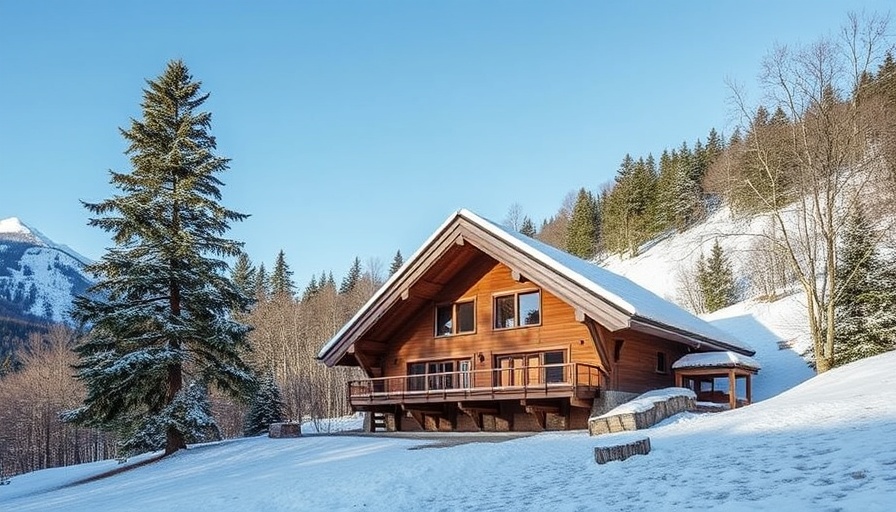
Embracing Beauty and Function in Swiss Architecture
In the realm of architecture, the intersection of aesthetics and functionality often generates fervent debates. One recent example stirring conversation is the residential complex designed by Pritzker Prize-winning architect Diébédo Francis Kéré and creative director Nachson Mimran in Switzerland. This project beautifully merges Swiss and African design traditions, offering a unique perspective on modern living in serene landscapes.
The feedback has been mixed yet passionate, with comments like "unexpected yet very beautiful" highlighting how the design defies conventional expectations for luxury homes. It exemplifies a potential path for future architectural endeavors - a blend of cultural influences that not only resonate with local traditions but also appeal to the principles of sustainable living.
The Role of Nature in Workspace Design
Digital nomads, especially those seeking comfortable remote workspaces, can draw inspiration from Kéré's approach. The design incorporates natural materials and integrates the home into its environment, reflecting a growing trend that values tranquility over the chaotic hustle typical in urban settings. For remote workers accustomed to office-like environments, designing workspaces that echo the calmness of Kéré’s architecture may enhance productivity and wellbeing.
For example, using natural light to illuminate a workspace can improve mood and mental clarity. Integrating plants or natural elements into your workspace will not only create a visually appealing setting but can also add psychological benefits by reducing stress and fostering creativity.
Creating Ergonomic Home Offices
When considering the design of a remote workspace, ergonomics plays a pivotal role. An effective workspace should not only be aesthetically pleasing but also functional and comfortable. Kéré's residential complex serves as a testament to this philosophy. Just like his design encourages connection to nature, workspace designers should focus on creating setups that cater to both physical and psychological comfort.
Incorporating ergonomically designed furniture, such as chairs and desks that promote healthy posture, is crucial. For instance, consider adjustable standing desks that allow users to alternate between sitting and standing throughout the workday, thereby promoting better health and reducing fatigue associated with prolonged sitting.
The Cultural Significance of Design
The architectural community is abuzz with debates around aesthetic values and cultural significance as demonstrated in the reactions to Kéré’s work. When building or redesigning personal spaces, incorporating elements that reflect one's cultural background or personal history can create a unique atmosphere. This could include traditional patterns, materials, or even art from one's heritage, making the workspace not just functional but also deeply meaningful.
For digital nomads who travel frequently, creating a portable workspace that showcases personal heritage can enhance the sense of belonging, no matter the location. This approach might involve using specific colors, textures, or elements that resonate personally but can be easily integrated, wherever they may set up their office.
Trends in Sustainable Architecture
As we absorb insights from projects like Kéré's, it’s crucial to acknowledge the wider trends in sustainable architecture that resonate with the ethos of modern living. The blend of aesthetic value with climate-responsive designs is significant in today's environment-focused dialogue. Eco-friendly building practices are not just a trend but a necessity in addressing the architectural sustainability challenges we face.
Whether you're a digital nomad or a homeowner, understanding these trends can help you make informed decisions about your space. Living in environments that prioritize sustainability can enhance personal wellbeing and positively impact the planet.
Conclusion: Designing Your Space Thoughtfully
In conclusion, the conversation around Kéré's residential complex offers valuable lessons not only for architects and designers but also for anyone looking to create a comfortable and efficient workspace. By integrating elements of nature, cultural significance, and ergonomic design, you can foster productivity and well-being in your remote work environment.
As the world continues to evolve towards remote work, taking cues from innovative designs can help you optimize your workspace for better health, enhanced creativity, and increased productivity. It's time to recognize the fundamental relationship between our surroundings and our effectiveness, especially in the nuanced world of digital nomadism. Design your workspace thoughtfully – it's not just about aesthetics; it’s about creating a base for success.
 Add Row
Add Row  Add
Add 




Write A Comment